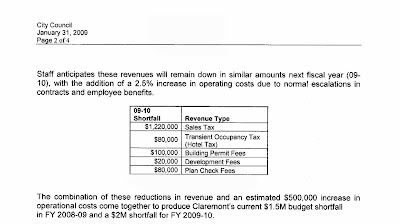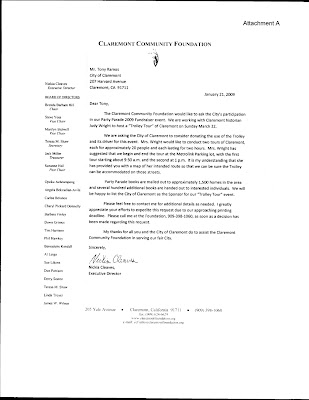 The Claremont City Council is having a special session meeting today that is open to the public. The meeting runs from 8am to noon in the Padua Room of the Alexander Hughes Community Center. The Hughes Center is located at 1700 Danbury Rd., just south of Scripps Rd. between Towne and Mountain Aves.
The Claremont City Council is having a special session meeting today that is open to the public. The meeting runs from 8am to noon in the Padua Room of the Alexander Hughes Community Center. The Hughes Center is located at 1700 Danbury Rd., just south of Scripps Rd. between Towne and Mountain Aves.
If you don't have anything better to do, or even if you do, you may want to get out to the meeting. The City Council will be discussing the worst financial situation it has faced since the early 1990's. The City is breaking the bad budget news it has quietly alluded to recently. According to the staff report for the meeting, the City of Claremont is facing a $3.5 million combined budget short fall for rest of this fiscal year and for FY 2009-10 - that's roughly 17 months.
The shortfall breaks down this way: $1.5 million for FY 2008-2009, the budget year ending June 30, 2009, and $2 million for FY 2009-10. We're not sure if these numbers include things like a possible June increase in the City's payments into its CalPERS employee pension account by up to a third of current payments, and there are numerous other variables: the housing market, the unemployment rate, the economy and the continued sales tax slump.
The staff report gives an analysis of the problem:
The City of Claremont is feeling the impacts of the current economic situation across the country and the world. While the City has been fortunate to not suffer as severely from the foreclosure crisis as some of our neighbors, nevertheless, Claremont's other key revenue sources are down. Automobile and other sales are down Transient Occupancy Tax paid by visitors staying at our hotels are down, and development has all but stopped.
The report gives a table showing the projected 2008-09 revenue shortfalls:

And here are the revenue shortfall figures for FY 2009-10:

In addition to the decrease in revenues, the remainder of the projected deficits will come from anticipated increases in operational expenses.
To address the shortfall, Claremont City Manager Jeff Parker has come up with a proposed plan to take $1,011,000 in "onetime unanticipated revenue" (money from grants and fees that the city received but did not budget for) and apply those towards the FY 2008-09 deficit.
The remainder of the deficit reduction for 2008-09 and 2009-10 will come from across-the-board departmental reductions, including reductions in employee benefits, which Parker and his senior staff have been negotiating with the employee unions.
Parker is asking the City Council to approve his recommendations for adjusting the 2008-09 budget, to receive and file Parker's draft 2009-10 budget plan, and to direct Parker to come back to the Council with a final 2009-10 plan on February 24th.
We should note that $2.2 million of the total deficit - about one-third - comes from the city's (primarily Mayor Ellen Taylor's) refusal to put off construction of the Padua Ave. Park until the fiscal crisis passes. Also, the downtown trolley represents a diversion of $1.2 million in funds that might have otherwise been used for traffic related projects like road repair and maintenance.
But Taylor and others see things like the park and the trolley one portion of their legacy to Claremont. The deficit, which may turn out to be larger than projected if the economy does not improve soon, will be the other.
Below is the staff report for today's special budget meeting. Click on the box in the upper right corner of the window to view a full-screen version of the document.
1 31 09 City Budget Report



























